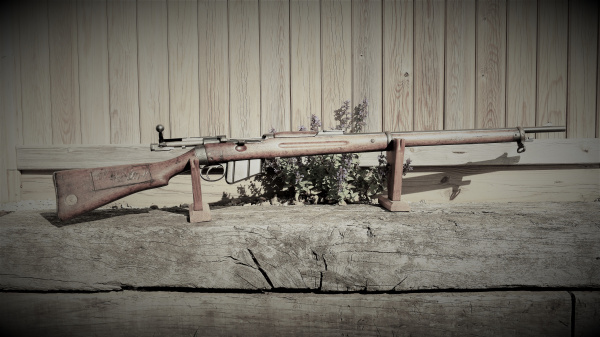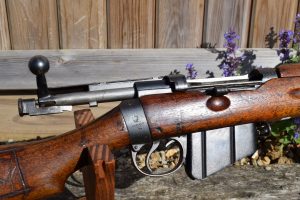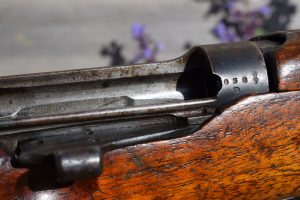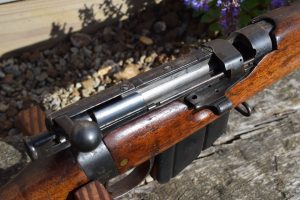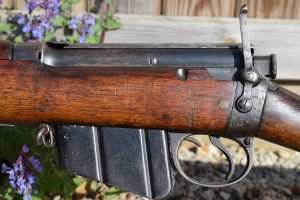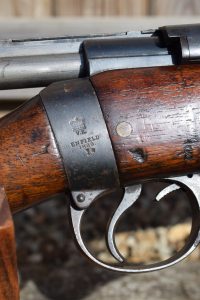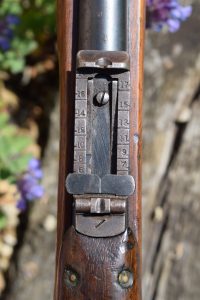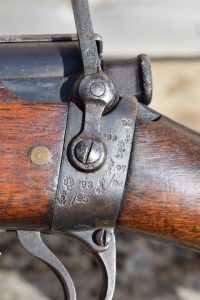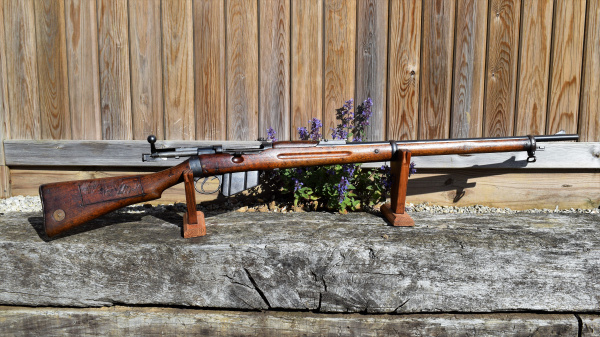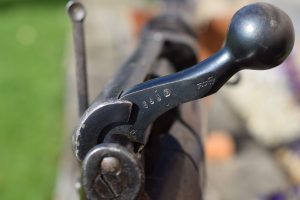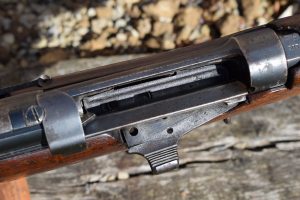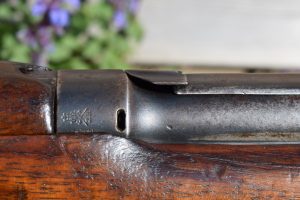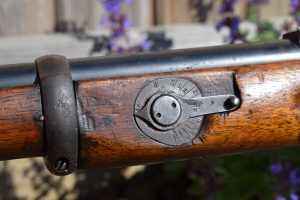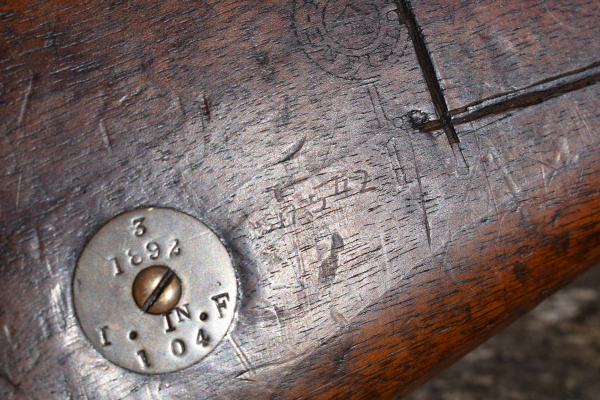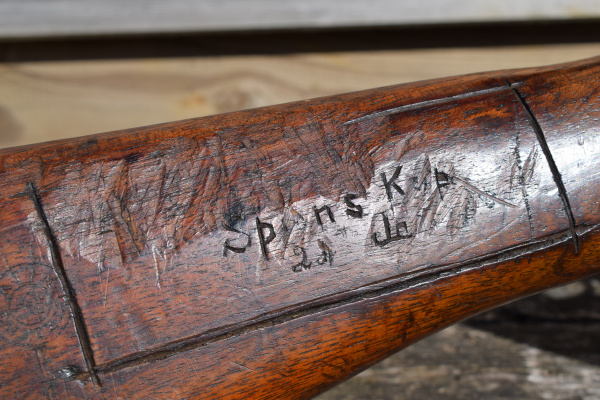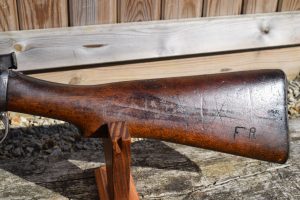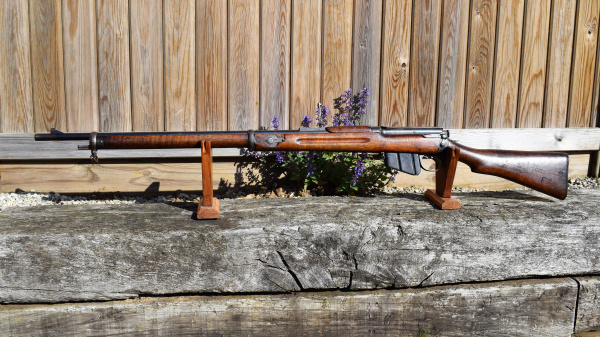Boer War Lee-Metford Mk I* Rifle….(F 1044) SOLD
Created on June 25th 2022
Extremely interesting Mk I* Metford with Boer War History
Of absolute and standard Military specifications. Built by Enfield in 1889 being a Mk I but later being up-dated with the modifications associated with the Mk I*. Chambered in .303 with a single stack 8 round detachable box magazine. The barrel still has the original 7 groove Metford LH twist rifling. Overall the rifle is 49.1/5″ long. The round blued barrel is a nominal 30.1/8″ long and the trigger Pull is 13.1/2″ to centre. The rifle is stocked in a dark, mellow English Walnut with a finger grooved fore-end and a very short hand-guard over the barrel.
This Mk I* carries the serial number “638 D” on the RHS of the receiver ring and the rear of the bolt arm. The bolt is fitted with a dust cover which is held in place with two screws. It also has a “D” shaped cocking piece. Below the bolt slide is the magazine cut-off and a characteristic indent in the stock below, to aid its use. The rear LHS of the action has the aperture arm for the long range volley sight; the safety which used to reside in this same position has been removed in the upgrade and a new notch-less cocking piece put in place.
The RHS of the wrist is marked with the Victorian cypher / V.R. / ENFIELD / 1889 / I*” On the LHS of the wrist are many inspection marks all dated, ranging from 1893 to 99. Also originating from different locations including Birmingham, Enfield (RSAF) amongst others, in short the life story of the rifle in official hands. However there is more…… The upgraded rear sights are graduated to 1800 yards with the new “V-notch” aiming aperture. The front sight is a simple inverted “V” on a ramp. The long range volley sight dial and arm are in position half way along the fore-end with “WD” markings applied, ranging from 1600 to 2900 yards. Bayonet mounting lug and forward sling swivel with stacking link. Rear sling mount is forward of the magazine- link between magazine and rear sling mount a(/f). Serrated trigger. Steel butt-plate with trap for cleaning equipment “WD” marked.
The RHS of the butt stock is also cartouche marked, although faint it can be seen to read in a circular form “R. crown. M. / ENFIELD, around a “WD arrow“. over 1 . 1*” The next most important marking to take into account is the brass disc unit marking on the RHS of the butt. This is a clear and completely original marking to the rifle, from the top it reads; “3 / 1982 / I. IN. F / 104” Obviously dated but belonging to the 1st Battalion the Royal Innskilling Fusiliers, being rifle no 104. Upon very close inspection it is possible to see an imprint of “s n 542” on the side of the butt, as if written with a pencil on a thin piece of paper, whilst leaning on the buttstock for a flat surface. This could mean “Service Number 542”? The service numbers for the individual soldiers were three and four digit numbers. Who was number 542? It is very very rare to be able to connect a service rifle with a name as there is usually no connecting evidence. Further investigation is warranted. If we find who 542 was and he was lost or wounded at Colenso then we have a link which can not be ignored.
The 1st Royal Inniskilling Fusiliers were involved in the Second Boer War almost immediately after their arrival in South Africa. The 1st Battalion sailed on the Catalonia on 5th November 1899, arrived at the Cape about the 30th, and was sent to Durban. They were heavily bloodied in combat at the Battle of Colenso where they lost many men and much equipment. It is thought that this rifle fell into the hands of the Boers at that battle. The carvings on the RHS of the butt stock attest to just this scenario. At first one can see a rectangular border crudely carved into the butt, as the Boers were famous for. Within that border a large section towards the upper half that has been crudely removed, it is supposed that this could have been the place of capture of the rifle namely Colenso. However then the word Colenso has been removed ! Who would do such a thing but possibly a British Soldier not wanting a Boer victory recorded on a British Rifle. If so, then it is reasonable to assume that the person that removed that first mark then applied the main marking which reads “Spions Kop / 22 Ja_” The interesting thing is that the spelling has been executed in a British manner, as the Afrikaans would be Spioenkop as one word. So it is the Authors suggestion that this rifle was retaken at the later battle. But academics can argue over that until the cows come home. I am just trying to describe what is in front of me. It is however extremely interesting………. On the other side of the butt are the simple initials “F R”
This is a superb piece of history on a rare and fine rifle in very good condition both inside and out. The bore is very good for a Metford and the rifle mechanically fine. What we have here is vastly more important than just another historic full bore rifle; but a rifle from the Bloody opening of a very Bloody Century. This rifle will be debated over bitterly but there is one thing that is absolutely an unavoidable fact; this is without doubt one of the most historic pieces that has emerged on to the British Collectors market for a very long time. A chance not to miss.
Stock No F 1044
£ 1950. SOLD
Comments Off on Boer War Lee-Metford Mk I* Rifle….(F 1044) SOLD
